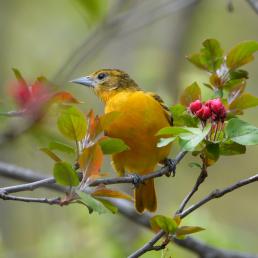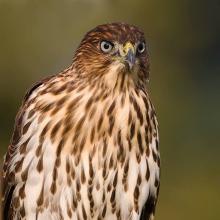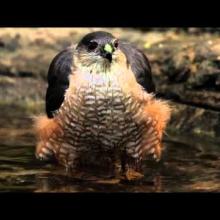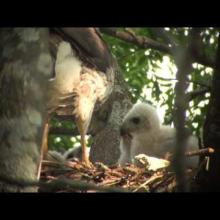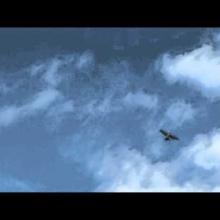One of the most difficult skills to pick up as a birder is how to identify birds in flight. You have to sort through a series of visual clues all at once, at high speed: silhouette, wing shape, how fast it flaps, and patterning. An experienced birder will take in all these and other clues that are hard to put into words. So if you hang around long enough, you might hear some interesting slang.
BirdNote®
ID-ing a Bird In Flight
Written by Bob Sundstrom
This is BirdNote.
[Sky Lark song fragment, http://macaulaylibrary.org/audio/30206, 0.04-.09]
One of the most difficult skills to pick up when you start noticing birds is how to identify one in flight. You have to sort through a series of visual clues all at once, at high speed: silhouette, wing shape, how fast it flaps, dark and light patterning. An experienced birder will take in all these and other clues. So if you hang around long enough you might hear something like: “Look! A hawk! Must be a Cooper’s Hawk — it has that giss.” In other words, it has all the telltale signs. But where did this bit of birding slang originate?
[Sound of warplanes overhead]
One explanation takes us back to World War II, when trained spotters scanned the skies and identified airplanes by a coded system called General Impression of Size and Shape, or G-I-S-S. Each plane — enemy or friend — had a G-I-S-S. Birders simply borrowed the concept, spelling the word by its sound — jiz.
[Sky Lark song fragment, http://macaulaylibrary.org/audio/30206, 0.04-.07]
Makes perfect sense. Except some birders apparently used the word as early as 1920. Which has led to speculation that it’s derived from the word “gist.” Whatever the origin, getting a General Impression of the Size and Shape is a good start for identifying a bird in flight.
For BirdNote, I’m Mary McCann.
###
Senior Producer: Mark Bramhill
Producer: Sam Johnson
Managing Editor: Jazzi Johnson
Content Director: Jonese Franklin
Bird sounds provided by The Macaulay Library of Natural Sounds at the Cornell Lab of Ornithology, Ithaca, New York. Sky Lark [30206] recorded by Jean-Claude Roché
BirdNote’s theme music was composed and played by Nancy Rumbel and John Kessler.
© 2016 Tune In to Nature.org February 2016 / January 2023 / February 2025 Narrator: Mary McCann
ID# birding-24-2016-02-10 birding-24


